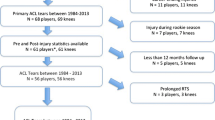Abstract
Surgical treatment for chondral defects of the knee in competitive running and jumping athletes remains controversial. This study evaluated the performance outcomes of professional basketball players in the National Basketball Association (NBA) who underwent microfracture. Data from 24 professional basketball players from 1997 to 2006 was obtained and analyzed. NBA player efficiency ratings (PER) were calculated for two seasons before and after injury. A control group of 24 players was used for comparison. Study group and control group demographics including age, NBA experience, and minutes per game demonstrated no statistical difference. Mean time to return to an NBA game was 30.0 weeks from the time of surgery. The first season after returning to competition PER and minutes per game decreased by 3.5 (P < 0.01) and 4.9 min (P < 0.05), respectively. The 17 players who continued to play two or more seasons after surgery, the average reduction in their PER and minutes per game was 2.7 (P > 0.05) and 3.0 min (P < 0.26), respectively. A multivariant comparison versus controls demonstrated that power rating during the 2 years after surgery decreased by 3.1 (P < 0.01); while minutes per game decreased by 5.2 (P < 0.001). Twenty-one percent (n = 5 of 24) of the players treated with microfracture did not return to competition in an NBA game. On return to competition player performance and minutes per game are diminished.


Similar content being viewed by others
References
Buckwalter JA, Mankin HJ (1988) Articular cartilage repair and transplantation. Arthritis Rheum 41:1331–1342
Gobbi A, Nunag P, Malinowski K (2005) Treatment of full thickness chondral lesions of the knee with microfracture in a group of athletes. Arthroscopy 13:213–221
Gudas R, Kalesinskas RJ, Kimtys V et al (2005) A prospective randomized clinical study of mosaic osteochondral autologous transplantation versus microfracture for the treatment of osteochondral defects in the knee joint in young athletes. Arthroscopy 21:1066–1075
Irrgang JJ, Pezzullo D (1998) Rehabilitation following surgical procedures to address articular cartilage lesions of the knee. J Orthop Sports Phys Ther 28:232–240
Knutsen G, Engebretsen L, Ludvigsen TC et al (2004) Autologous chondrocyte implantation compared with microfracture in the knee. A randomized trial. J Bone Joint Surg Am 86:455–464
Marder RA, Hopkins G Jr, Timmerman LA (2005) Arthroscopic microfracture of chondral defects of the knee: a comparison of two postoperative treatments. Arthroscopy 21:152–158
Miller BS, Steadman JR, Briggs KK et al (2004) Patient satisfaction and outcome after microfracture of the degenerative knee. J Knee Surg 17:13–17
Mithoefer K, Williams RJ, Warren RF, Marx RG (2006) High-impact athletics after knee articular cartilage repair: a prospective evaluation of the microfracture technique. Am J Sports Med 34:1413–1418
Nehrer S, Spector M, Minas T (1999) Histologic analysis of tissue after failed cartilage repair procedures. Clin Orthop 365:149–162
Ritchie PK, McCarthy EC (2005) Surgical management of cartilage defects in athletes. Clin Sports Med 24:163–174
Rodrigo JJ, Steadman JR, Silliman JF et al (1994) Improvement of full-thickness chondral defect healing in the human knee after debridement and microfracture using continuous passive motion. Am J Knee Surg 7:109–116
Steadman JR, Briggs KK, Rodrigo JJ et al (2003) Outcomes of microfracture for traumatic chondral defects of the knee: average 11-year follow-up. Arthroscopy 19:477–484
Steadman JR, Miller BS, Karas SG et al (2003) The microfracture technique in the treatment of full-thickness chondral lesions of the knee in National Football League players. J Knee Surg 16:83–86
Steadman JR, Rodkey WG, Rodrigo JJ (2001) Microfracture: surgical technique and rehabilitation to treat chondral defects. Clin Orthop Relat Res 391:362–369
Acknowledgment
The authors would like to acknowledge Jason Liao, PhD for his assistance in statistical analysis.
Author information
Authors and Affiliations
Corresponding author
Rights and permissions
About this article
Cite this article
Cerynik, D.L., Lewullis, G.E., Joves, B.C. et al. Outcomes of microfracture in professional basketball players. Knee Surg Sports Traumatol Arthrosc 17, 1135–1139 (2009). https://doi.org/10.1007/s00167-009-0765-5
Received:
Accepted:
Published:
Issue Date:
DOI: https://doi.org/10.1007/s00167-009-0765-5




